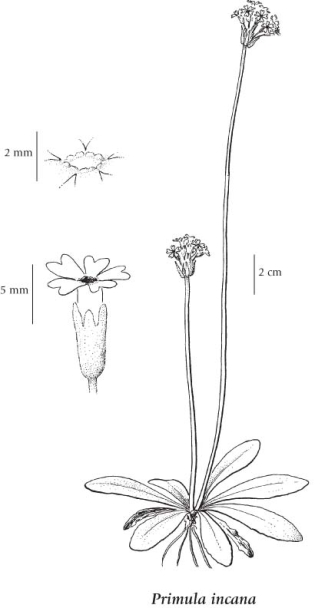mealy primrose (silvery primrose)
Primulaceae
Introduction to Vascular Plants
Species Information
General:
Fibrous-rooted, scapose, perennial herbs.
Leaves:
Leaves not succulent, elliptic to oblanceolate, apices acute to obtuse, bases tapering gradually to a broadly winged petiole, finely denticulate towards the apex, often slightly revolute, glabrous, often whitish- or yellowish-mealy (especially on basal portion), 1-6 cm.
Flowers:
Inflorescences of 4-19 flowers; involucral bracts flat to sac-shaped at the base, lanceolate, densely whitish- or yellowish-mealy, 5-10 mm. Flowers homostylous; corollas lavender with a yellow throat, lobes slightly to moderately cleft, lobes shallowly to moderately cleft, 4-8 mm wide; calyces glandular, densely whitish-or yellowish-mealy, lobes shorter than the tube, 4-10 mm; pedicels erect, densely whitish- or yellowish-mealy, 3-9 mm. Flowering May-Jul.
Fruits:
Capsules cylindrical to ellipsoid, 1.5-2 times calyx length; seeds without flanged edges
Stems:
Scapes conspicuously whitish- or yellowish-mealy throughout (especially when young), 6-45 cm tall.
Source: The Vascular Flora of British Columbia, draft 2014.
Author: Jamie Fenneman
Illustration

If more than one illustration is available for a species (e.g., separate illustrations were provided for two subspecies) then links to the separate images will be provided below. Note that individual subspecies or varietal illustrations are not always available.
Illustration Source: The Illustrated Flora of British Columbia
USDA Species Characteristics
Flower Colour:
White
Blooming Period:
Late Spring
Fruit/Seed characteristics:
Colour: Brown
Present over the Summer
Source: The USDA
Habitat and Range
Moist to wet meadows, streambanks, ledges, and disturbed areas (particularly on fine-textured alkaline soils) in the parkland, boreal, and montane zones. Infrequent in ne BC, rare in se BC; AK east to ON, south to UT, CO.Source: The Vascular Flora of British Columbia, draft 2014.
Author: Jamie Fenneman
Status Information
Synonyms
Synonyms and Alternate Names:
Primula farinosa var. incana
Taxonomic Keys
KEY TO PRIMULA
1a. Leaves succulent, with 5-11 coarse teeth towards the apex; corollas >10 mm across; capsules globose; seeds with flanged edges …….…………………………………….……………………P. cuneifolia 1b. Leaves not succulent, entire or wavy-margined to finely denticulate; corollas usually <10 mm across (to 14 mm in P. mistassinica); capsules ovate to cylindrical; seeds without flanged edges………................................…………………….2 2a. At least some leaves tapering abruptly to long, slender petioles; plants never whitish-mealy……………….................………3 3a. Involucral bracts lanceolate, sac-shaped but without ear-shaped appendages at the base; flowers homostylous; corollas 6-10 mm wide…………………………………………………………………P. egaliksensis 3b. Involucral bracts oblong to oblong-lanceolate, with ear-shaped appendages at the base; flowers heterostylous; corollas 9-20 mm wide…………………………………………………………[P. nutans] 2b. All leaves tapering gradually to wide petioles; some plants whitish- or yellowish-mealy (especially P. incana)..……….……4 4a. Plants robust, to 45 cm tall, conspicuously whitish- or yellowish-mealy (especially on calyces, involucral bracts, and scape); corolla lavender, 2-4 mm long; calyx lobes shorter than the tube; flowers homostylous......................P. incana 4b. Plants relatively slender, to 20 cm tall, not or only slightly whitish- or yellowish-mealy; corolla lobes pink to violet (rarely white), 4-7 mm long; calyx lobes equalling or exceeding the tube; flowers heterostylous……........P. mistassinica
Source: The Vascular Flora of British Columbia, draft 2014 |
Taxonomic Notes
This is the only Primula species in which the mealy coating is dense and extensive, rendering it easily identified under most circumstances. It is also distinctive in its large size, stout scapes, and densely-flowered inflorescences of relatively small flowers.
Source: The Vascular Flora of British Columbia, draft 2014 |